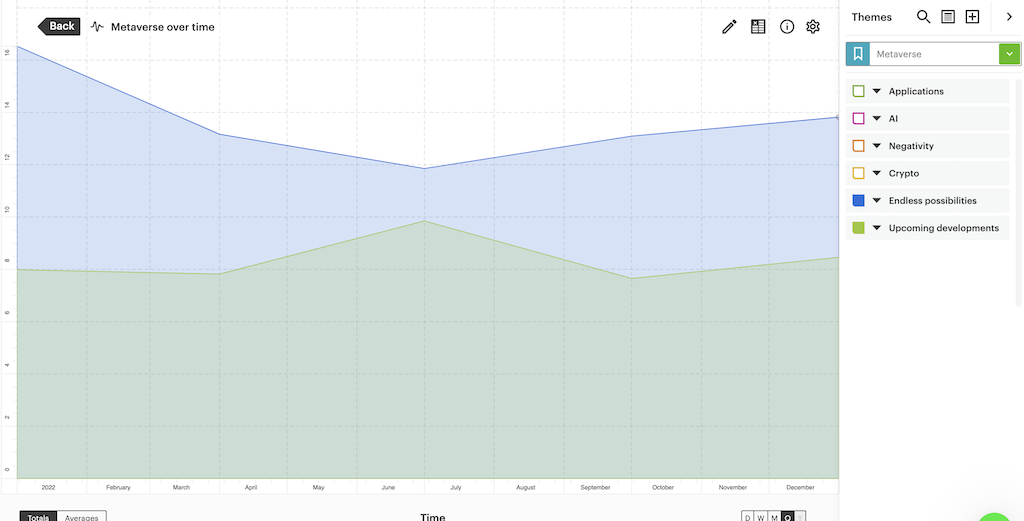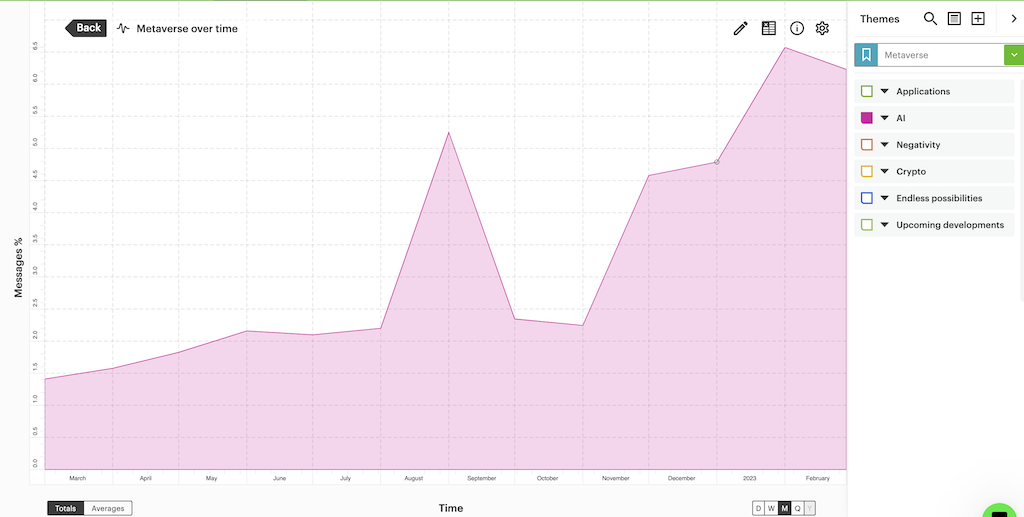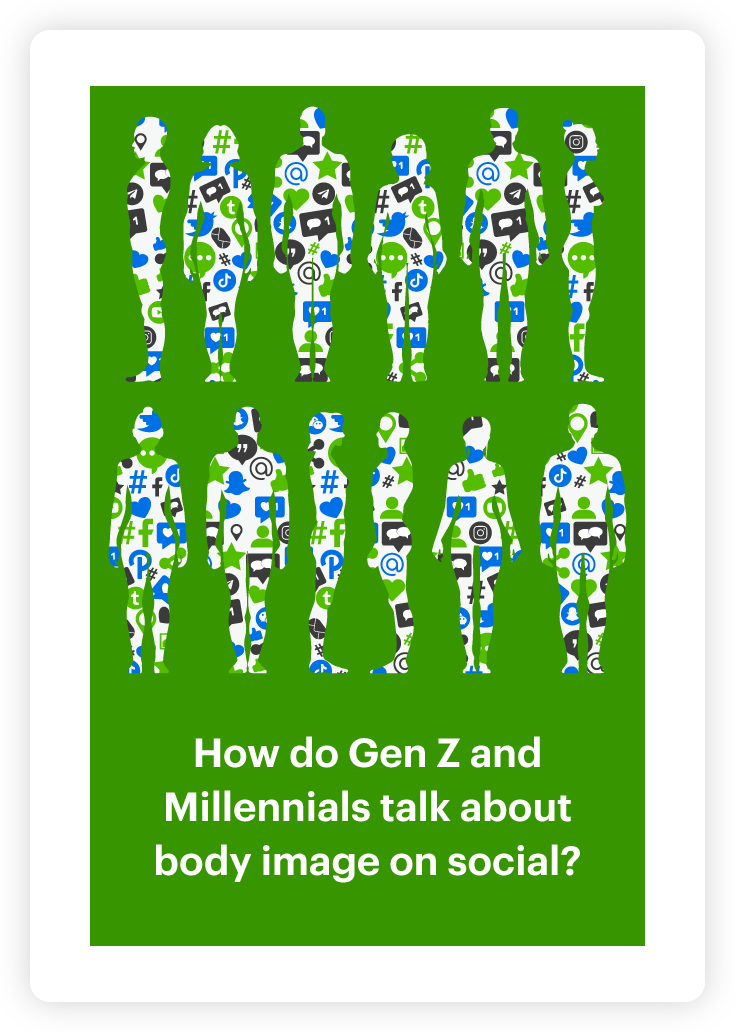Tracking online discussions to find out what happened to the metaverse

The metaverse rocketed into public consciousness following Facebook’s rebrand to Meta – along with the accompanying launch video featuring CEO Mark Zuckerberg in this virtual universe. However, with tech conversations now seemingly focusing on the potential of ChatGPT and other AI tools, we wanted to find out whether the way people are discussing this intangible world has changed.
Using a combination of Relative Insight Explore and Relative Insight Heartbeat, we uncovered the themes from one year’s worth of conversations about this virtual world on Twitter. Amounting to more than three million words, Relative Insight’s text analytics tools identified and tracked key themes contained within the tweets in under 90 minutes. This helped to answer a burning question: What happened to the metaverse?
The analysis found that much of the hype around this world is driven by cryptocurrency conversations. It’s therefore no surprise that the number of people tweeting about this once-trending parallel world has fallen in volume – echoing the fast-moving world of crypto where adopters are always looking towards the next big thing.
Conversations on the metaverse relating to ‘cryptocurrency’ appeared 5.9x more in early 2022, with tweeters appearing to lose interest as they realized the alignment between the virtual world and new currencies would be slow – rather than a big bang. This is visualized through a Heartbeat chart – with conversations decreasing rapidly until the fall, after which they experience a small revival.

Relative Insight’s full analysis into how people talk about this new world is below. If you want to efficiently uncover quantifiable trends found within large volumes of text data, book a discovery call with one of our experts to learn how to get the most from your text data.
Declining notoriety – the journey from 36,000 to 8,000 tweets
If judging solely by the volume of tweets, people are losing interest in the metaverse. By using a social listening tool to gather Twitter conversations we found that, in March 2022, there were 35,600 tweets relating to this new world. In comparison, there were only 8,600 in February 2023. However, looking at the number of tweets doesn’t give an indication for the reasons behind this fall. Analyzing tweets’ content does.
Relative Insight analyzed 234,000 tweets in total, splitting them into four distinct categories based on volume:
- March 2022 – April 2022: Tweet volume ≈36,000 per month
- May 2022 – July 2022: Tweet volume ≈15,000 per month
- August 2022 – November 2022: Tweet volume between 16,000 and 22,000 per month
- December 2022 – March 2023: Tweet volume less than 10,000 per month
This facilitated comparison between each time period, which is vital to the quantification of insights and themes contained within text data – achieved using Relative Insight Explore. As well as uncovering the prevalence of cryptocurrency conversations, the research surfaced tweets relating to five other themes: ‘endless possibilities’, ‘upcoming developments’, ‘applications’, ‘negativity’ and ‘AI’.
Plotting and visualizing these themes in Relative Insight Heartbeat demonstrated how discussions around this ethereal world have evolved.
Lack of real-life metaverse applications leads to 1.5x rise in negativity
Early in 2022, tweeters were excited about the technology’s potential. They were 2.2x more likely to use language related to ‘expectation’, such as ‘bullish’, ‘predict’ and ‘expect’. Conversations also focused upon things people wanted to do in the virtual world, such as ‘fly’ (1.3x) or even to become ‘pregnant’ (4.5x). These insights were grouped into the theme of ‘endless possibilities’.
Tweeters also highlighted developments which had the potential to expand the world’s functionality. They were 2.3x more likely to discuss ‘projects’ and ‘plans’ – which form the ‘upcoming developments’ theme.
Plotting these themes in a Heartbeat chart demonstrates that they’re inversely proportional. When people talk about real-life projects mooted for this new universe, they’re less likely to discuss what the applications could be.
Or, to put it another way, the reality of what’s actually being developed within the metaverse doesn’t correspond with tweeters’ imaginations.

In late 2022, people were 3.4x more likely to describe it as a ‘failure’ and called it ‘bad’ 1.4x more. Tweeters also used the word ‘exist’ 1.6x more, highlighting either that the virtual world was trying to solve problems that “didn’t exist”, or was recreating elements that “already exist”.
“Every single thing about the metaverse is just something that exists but now looks worse and costs more.“

The Heartbeat chart illustrates that, as the amount of time without tangible, exciting applications of the metaverse increased, the greater the negativity directed towards it.
AI 4.4x more likely to dominate at the turn of the year
The effect of ChatGPT’s launch in late 2022 is clear to see – even in discussions related to the metaverse. Tweeters were 4.4x more likely to talk about ‘artificial intelligence’ and brought up words relating to ‘programming’ and ‘computing’ 2.4x more, such as ‘code’, ‘data’ and ‘system’.
These discussions took three main forms – lists of tech trends, comparisons between the technologies and, most interestingly, musings over how AI could be incorporated into the virtual world.
“Artificial intelligence should be developed by integrating it into the metaverse.“
The Heartbeat chart visualizes this increased focus on AI and technology. Discussions around systems, data and coding led to the midsummer spike, while ChatGPT’s launch and the greater focus on artificial intelligence is responsible for the rapid increase in AI-related conversations in November and beyond.

It’s clear that AI became technology’s golden child at the beginning of 2023 – despite there still being some general interest in the metaverse.
How can the metaverse match people’s expectations?
Analyzing tweets about the metaverse over the course of a year has revealed a clear narrative in how people view it.
While tweeters were initially enthused by the concept of a virtual world, the lack of applications, particularly ones which capture the public’s imagination, has led to people writing it off. Whether this is down to a lack of progress or poor communication around developments, companies looking to drive adoption within the metaverse haven’t yet given people a compelling reason to join it.
Just as an interactable, accessible chatbot turbocharged people’s interest in artificial intelligence, the falling engagement and rising negativity towards the virtual world could be reversed with an irresistible reason for people to change their minds.
By comparing conversations over time using Relative Insight Explore and Heartbeat, this study has uncovered some of the themes and trends permeating through Twitter discussions about the metaverse. To find out how you can find and quantify trends through text data, speak to one of our experts.
